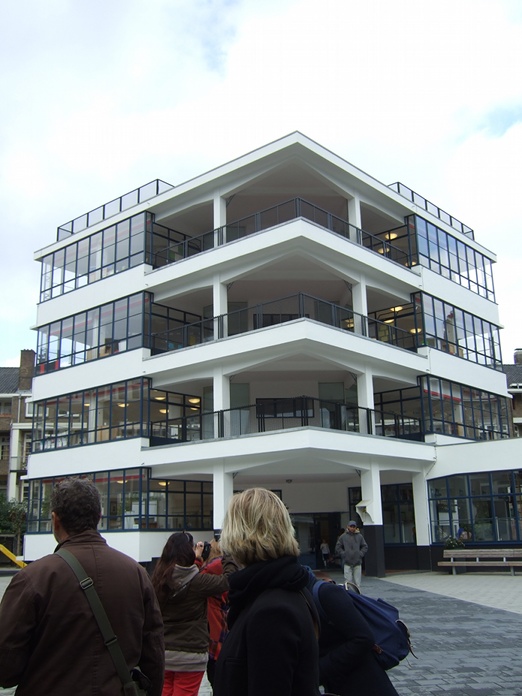Some people may remember taking the fast turn around the corner into the Cliostraat for the very first time in their lives. I do. Others remember being safely tucked in a seat on dad’s bike, speeding through the grey streets of Amsterdam, early in the morning on a sunny day in September. Suddenly dad’s brakes and stops in front of a building quiet different from buildings you are used to know. The whole neighborhood seems like one grey mass of brick, but this building looks different. You get pulled of the bike, dad takes you by the hand and leads you through a gate onto a large playground. The glass building overlooking the square completely dominates the open space formed by the surrounding buildings, not by sheer size but by its open form, the glass used and the clean paintwork. Placed diagonally in the open space, it seems to form a glass palace, safely hidden by the housing blocks surrounding it, protecting, but also open and inviting.
eerste openluchtschool voor het gezonde kind
This hidden glass palace was designed by Jan Duiker. Duiker was born in 1890 in The Hague and studied building in Delft. In 1916 he started his own architectural firm together with Bernhard Bijvoet. The two had met in Delft and worked together at the architectural firm of Henri Evers and in this period they worked on several buildings, the most famous example being the town hall of Rotterdam(1914-1920). A palace as well, but still owing much to the Amsterdam School and the works of Berlage. Quiet different from the glass buildings Duiker was to design in the near future. In 1918 Duiker won a contest and was commissioned by the Dutch government to build the new Rijksacademie building, but due to the unhealthy financial climate in the wake of the First World War his plans were never realised. The prize money, however, allowed him to start a new firm in Zandvoort. Financial problems ended the professional collaboration with Bijvoet, who left for Paris in 1925. Duikers career was as short as it was groundbreaking. He died at the age of 45 in 1934.
Duiker was an extremely skilled architect, who seemingly without trouble solved the most difficult problems in designing his trademark buildings and his style is best described as being light, frequently using glass, open and with the use of square shapes. Most of his designs, such as The Cineac at the Reguliersbreestraat in Amsterdam and Nirwana in The Hague, the first flat in The Netherlands are landmarks and still to be seen today. He was interested in the most advanced building techniques of his days, and wasn’t afraid of implementing these either, his frequent collaborations with concrete pioneer Jan Wiebinga are a prime example of this. One of their most famous projects together is the sanatorium ‘Zonnestraal‘ (Sunbeam) in Hilversum (1926-1928). A large open building, made out of glass and concrete, bearing all the trademarks of Duiker, build in a style perfectly suiting the needs of those recovering from lung diseases, proving he always kept the function of the building he was designing in mind.
Duiker’s unique style placed him at the avant garde of an international building movement also know as ‘Het Nieuw Bouwen’ (New Building, or Modern Building). A movement containing such variety in architectural styles one article is far from sufficient to describe all its elements. In short, modern building is best characterised as sturdy yet light, sober and functional. It’s straight shapes and lack of ornamentation provide a stark contrast with its more lavishly decorated architectural predecessors. The Fagus Factory (1911) in Germany by Walther Gropius is universally considered to be the first building being designed according to the standards of Modern Building, and up to this day architects borrow from the ideas that form this unique way of building. Modern building is not without it’s flaws however, it’s strict separation of functions for example tend to make living areas uninhabited at office time, creating ghost town like suburbs, a development condemned by many, leading to combining multiple functions in buildings to provide more vibrant surroundings.
The square, glass building in the Cliostraat is still there, almost twenty years later. The schoolyard is still the scene of parents delivering their children to school, as they did thirty years ago, or even eighty years ago perhaps at the very opening in 1929. As far as I am concerned this seemingly ongoing ritual forms a testimony to the timelessness of Modern Building, the ‘Eerste Openluchtschool voor het Gezonde Kind’ (first open air school for the healthy child) still functions as a school, virtually unchanged in its original design. In its shape, it’s seems to incorporate elements that remind me of the grandeur of Rotterdams town hall, but also the openness of Hilversums sanatorium. The surrounding buildings still embrace the playground and the school, providing a safe environment in which to play and learn, while the school’s open façade and glass front enable enough light to enter, not to make children feel locked in. As a child you may not be aware of the school’s uniqueness, but parents have been for over eighty years, and I’m sure countless children will take their first turn into the Cliostraat for many years to come.

